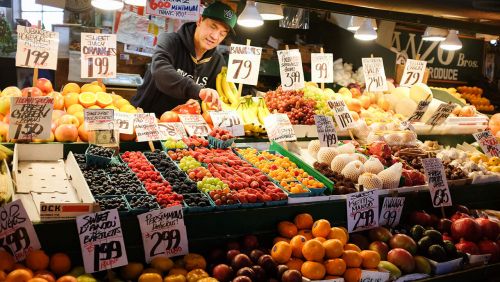Seven Reasons to Feel Hopeful About the Food System in the Midst of the Pandemic

Alesha Miller shares what hopeful news is emerging in America during the COVID-19 pandemic.
Introduction
These days, it feels like there’s a lot of talk of losing ground and of things breaking under the pressure of the post COVID-19 reality. But history seems to indicate that in the midst of things being broken, new things are being built too. There will, in fact, be winners in the food system just as much as there are losers. So, rather than focus on where things are being lost, here is where things are durable or where new things are emerging in America:
Good news
A return to growing and cooking at home. As consumers stay home, they are rediscovering the joy and peace of growing their own food and cooking. Articles abound around consumers buying baby chicks and heirloom seeds in record numbers and the explosion of Google searches for recipes shows we’re returning to the kitchen in many places around the world. Here are the ten most searched in the last month.
Direct to Consumer Food Models
As consumers become less interested in going to the grocery store, but perhaps more interested in sustainable, fresh food, Community Supported Agriculture (CSAs) seem to be making a comeback, but it’s not just them. Specialty food purveyors and restaurants are selling products and ingredients directly to consumers as a strategy to increase income and customers are lining up. This may also mean that indoor growing operations leverage more direct-to-consumer models too as the savvy consumer looks for them and the retail location becomes less essential.
Beans
Beans have long had an image problem in many parts of the world: they can be associated with poverty, making them less appealing to eat, even if they are an excellent source of nutrition, and tasty. Given their shelf-stability, versatility, and the variety that can be found if you look for it, this may be the beginning of a bit of bean renaissance, especially if the trend of outbreaks of COVID-19 in meat processing plants puts new stress on the animal protein industry.
Processed foods make a comeback
There is a difference between processed food and ultra-processed food that many consumers do not distinguish. Your peanut butter and your flour are both minimally processed foods. Your canned anchovies, tomatoes or preserves are processed. Candy, on the other hand, is an ultra-processed food; it contains many added ingredients and likely artificial colors and flavors. In the age of the well-stocked pantry, processed foods are demonstrating their utility and consumers are newly grateful to the food companies who provide them, many of them large companies that have had lagging popularity in the last few years. Consumers are likely to keep pushing for simpler ingredients and keeping the nutritional profile close to whole, but processed foods have an increasing role to play as fresh food supply chains face potential interruptions, even as we cook more at home.
New prepared food models
Despite our return to the kitchen, people still want to eat interesting food and so delivery for prepared foods. Some neighborhood restaurants will win and others will close forever; the National Restaurant Association estimates 3 percent already have. With all that industrial kitchen space, it’s likely that some will be come virtual restaurants (converting entirely to delivery models and perhaps offering services they wouldn’t normally have inside the restaurant) and some may become ghost kitchens: space that is used entirely to produce foods that are part of a virtual brand. Learn more about this by exploring companies like Cloud Kitchen.
New food preservation tech
While already on the rise, technologies like the coatings produced by Apeel Sciences that lengthen fresh food shelf-life will become more important.
Rural Connectivity will Create a (good) Boom
The race is on to increase rural internet access in the US and around the world. As rural areas come online, digital agricultural extension will go even further and so will tele-veterinary medicine (especially as the COVID-19 crisis resulted in a relaxation of regulation). This is likely to be a global trend, in fact. It will also spur appetite for IOT for Agriculture and blockchain innovations to make a smarter system that more easily traces food, connects supply and demand, and even has the ability to better protect worker rights. One might even imagine that rural areas themselves see a resurgence of new residents if connectivity enables remote work and far more space for increasingly cooped-up urbanites.
Conclusion
While the systems are coming apart, it’s good to remember what is working and what could work. The inventors and problem-solvers are thankfully working overtime these days and the connectivity of global networks has never been higher. The connectors need to go to work too, ensuring that innovations, wherever they are found, spread quickly and adapted to protect supply chains, sustainable agriculture, and food security.

